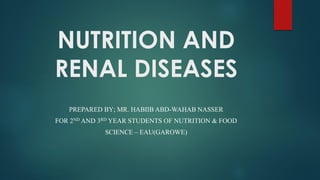
NUTRITION AND RENAL DISEASES LECTURE.pdf
- 1. NUTRITION AND RENAL DISEASES PREPARED BY; MR. HABIIB ABD-WAHAB NASSER FOR 2ND AND 3RD YEAR STUDENTS OF NUTRITION & FOOD SCIENCE – EAU(GAROWE)
- 2. KIDNEYS Kidneys is involved in the urinary system. They are responsible for filtering the blood and removing excess fluid and wastes for elimination in urine. The functional unit of the kidneys are the nephrons, which consists the glomerulus and tubules. The glomerulus, a ball-shaped tuft of capillaries, serves as a gateway through which blood components must pass to form filtrate. The glomerulus and surrounding Bowman’s capsule function like a sieve, retaining blood cells and most plasma proteins in the blood while allowing fluid and small solutes to enter the nephron’s system of tubules. As the filtrate moves through the tubules, its composition continuously changes as some of its components are reabsorbed and returned to the blood via capillaries surrounding the tubules; the remaining substances contribute to the final urine product.
- 4. Functions of the kidneys Filtering the blood to remove excess waste to form urine, The kidneys regulate the extracellular fluid volume and osmolarity(concentration of solutions expressed as total number of solute per liter), electrolyte (ions) concentrations, and acid–base balance. They also excrete metabolic waste products such as urea and various drugs and toxicants.
- 5. Other roles of the kidneys include the following: Secretion of the enzyme renin, which helps to regulate blood pressure. Production of the hormone erythropoietin, which stimulates the production of red blood cells in the bone marrow. Conversion of vitamin D to its active form, thereby helping to regulate calcium balance and bone formation.
- 6. NEPHROTIC SYNDROME Nephrotic syndrome refers to a condition caused by significant urinary protein losses (proteinuria) that result from severe glomerular damage. The condition arises because damage to the glomeruli increases their permeability to plasma proteins, allowing the proteins to escape into the urine. The loss of these proteins may cause serious consequences, including edema, blood lipid abnormalities, blood coagulation disorders, and infections. In some cases, the nephrotic syndrome can progress to kidney failure.
- 7. CAUSES OF NEPHROTIC SYNDROME. Causes of the nephrotic syndrome include; Glomerular disorders, Diabetic nephropathy (Kidney disease as a result oof increased blood sugar levels), Immunological and hereditary diseases, Infections (involving the kidneys or elsewhere in the body), Chemical damage (from medications or illicit drugs), Some cancers. Depending on the underlying condition.
- 8. CONSEQUENCES OF THE NEPHROTIC SYNDROME Although protein losses vary, proteinuria in adult patients may average as much as 10 grams daily. The liver tries to compensate by increasing its synthesis of various plasma proteins, but some of the proteins are produced in excessive amounts. The imbalance in plasma protein concentrations contributes to a number of complications which include the following; Edema (swelling caused by excess fluids in the body tissues) Blood Lipid and Blood Clotting Abnormalities: Loss of immunoglobulins (antibodies) and vitamin D–binding protein
- 9. Edema: Albumin (protein soluble in water) is the most abundant plasma protein, and it is the protein with the most significant urinary losses as well. The hypoalbuminemia characteristic of the nephrotic syndrome contributes to a fluid shift from blood plasma to the interstitial spaces and, thus, edema. Impaired sodium excretion also contributes to edema: the nephrotic kidney tends to reabsorb sodium in greater amounts than usual, causing sodium and water retention within the body.
- 10. Blood Lipid and Blood Clotting Abnormalities: Individuals with the nephrotic syndrome frequently have elevated levels of low-density lipoproteins (LDL) – bad cholesterol Furthermore, blood clotting risk is increased due to urinary losses of proteins that inhibit blood clotting. The nephrotic syndrome is associated with increased risk of heart disease and stroke.
- 11. Other Effects of the Nephrotic Syndrome: The proteins lost in urine include immunoglobulins (antibodies) and vitamin D–binding protein. Depletion of immunoglobulins increases susceptibility to infection. Loss of vitamin D–binding protein results in lower vitamin D and calcium levels and increases the risk of rickets in children. If proteinuria continues, protein-energy malnutrition (PEM) and muscle wasting may develop.
- 12. TREATMENT OF THE NEPHROTIC SYNDROME Medical treatment of the nephrotic syndrome requires diagnosis and management of the underlying disorder responsible for the proteinuria. Complications are managed with medications and nutrition therapy. The drugs prescribed may include diuretics, angiotensin- converting enzyme (ACE) inhibitors and angiotensin-receptor blockers (which reduce protein losses). Nutrition therapy can help to prevent PEM, alleviate edema, and correct lipid abnormalities.
- 13. NUTRITION RECOMMENDATION TO MANAGE NEPHROTIC SYNDROME Protein and Energy: Meeting protein and energy needs helps to minimize losses of muscle tissue. High-protein diets are not advised, however, because they can exacerbate or worsen urinary protein losses and result in further damage to the kidneys. The protein intake should fall between 0.8 and 1.0 gram per kilogram of body weight per day. An adequate energy intake (about 35 kcalories per kilogram of body weight daily) sustains weight and spares protein. Weight loss or infections suggest the need for additional energy.
- 14. Lipids: A diet low in saturated fat, trans fats (unhealthy fat that’s solid at room temperature), and refined sugars may help to control elevated low density lipoprotein LDL (bad cholesterol) levels. Stay away from foods like, butter, palm and coconut oils, cheese and red meat. Dietary measures are usually inadequate for controlling blood lipids, however, so physicians may prescribe lipid lowering medications as well.
- 15. Sodium and Potassium: Controlling sodium intake helps to control edema; therefore, the sodium intake may be limited to 1000 to 2000 milligrams daily. If diuretics prescribed for the edema cause potassium losses, patients are encouraged to select foods rich in potassium. NB: Diuretics are medicines that increase urine formation.
- 16. Vitamins and Minerals: Multivitamin/mineral supplementation can help patients avoid nutrient deficiencies. Nutrients at risk include iron and vitamin D. To reduce risk of bone loss, calcium supplementation (about 1000 to 1500 milligrams per day) may also be advised.
